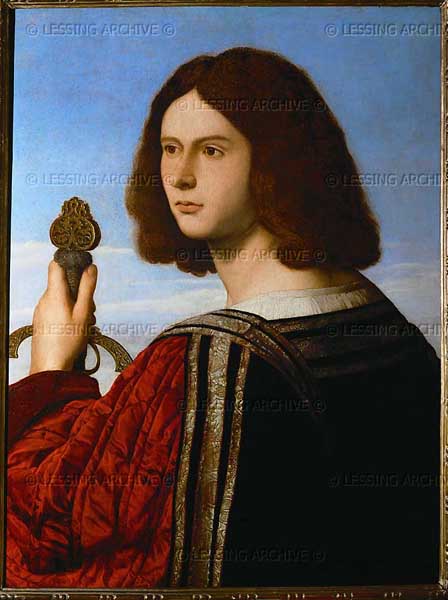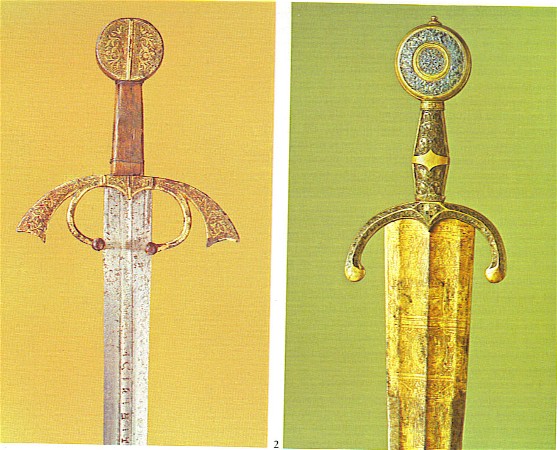| Author |
Message |
|
Alexander Serebrenik
Location: The Netherlands Joined: 23 Nov 2004
Posts: 5
|
 Posted: Tue 23 Nov, 2004 10:29 pm Post subject: Can you identify the sword? Posted: Tue 23 Nov, 2004 10:29 pm Post subject: Can you identify the sword? |
 |
|
Dear all,
Recently I came across the following painting by Italian artist Bartolomeo Veneto (1490-1550):
http://www.lessing-photo.com/p3/400801/40080113.jpg
This painting is supposed to portray Francesco Maria della Rovere (1490-1538), Duke of Urbino. It can be found in Accademia Carrara, Bergamo, Italy.
I wonder what kind of sword does the man hold? It seems that it has a rather special handle...
Best regards,
Alexander
 Attachment: 36.38 KB Attachment: 36.38 KB

|
|
  |
 |
Nathan Robinson
myArmoury Admin


|
 Posted: Wed 24 Nov, 2004 2:41 am Post subject: Posted: Wed 24 Nov, 2004 2:41 am Post subject: |
 |
|
My first thing would be to question if the sword in the portrait is of an actual sword or simply an artistís rendering of a typical sword of the time. In my studies, Iíve found that portraits containing weapons and armour were almost always depictions of actual pieces. The exceptions to this rule generally come when the portrait is not contemporary to the subject matter or when the portrait is inspired by another portrait. The first is not true in this case. The second: who knows?
Anyway, I donít know that Iíve seen that actual sword. I can say, however, that it looks somewhat like many Venetian side-sword hilts. But more than that, it looks similar to many typically Spanish hilt forms of the late 15th century. There are several of these in the Real America, Madrid museum.
This post shows one such example.Iíll post more examples some other time.
.:. Visit my Collection Gallery :: View my Reading List :: View my Wish List :: See Pages I Like :: Find me on Facebook .:.
|
|
    |
 |
Roger Hooper

|
 Posted: Wed 24 Nov, 2004 7:46 am Post subject: Posted: Wed 24 Nov, 2004 7:46 am Post subject: |
 |
|
|
It looks like Francesco's head was added to a painting with a pre-existing body. The two don't fit together in a seamless manner.
|
|
  |
 |
Craig Johnson
Industry Professional

|
 Posted: Wed 24 Nov, 2004 9:15 am Post subject: Hilt details Posted: Wed 24 Nov, 2004 9:15 am Post subject: Hilt details |
 |
|
This is a fairly typical ornate piece from that period and region. There is a strong relationship between Italy and Spain during the period as far as fashion and cultural decorations. The grip illustrates one of those period details that no one is very keen on in todays markets. Grips would often have pom poms of fringe at the top and bottom on higher end pieces they would have had fabric coverings and often netting or cord wraps of knots and special weaves. These elements are seen on surviving pieces in some collections but many have been lost as they were not as popular with victorian collectors and many grips would have been redone in current styles after the sword had passed into decorative/collection use rather than being worn and carried.
Best
Craig
|
|
    |
 |
|
Alexander Serebrenik
Location: The Netherlands Joined: 23 Nov 2004
Posts: 5
|
 Posted: Wed 24 Nov, 2004 11:44 am Post subject: Posted: Wed 24 Nov, 2004 11:44 am Post subject: |
 |
|
Dear all,
Thank you for your help so far. I wanted to add that despite the rare correlation between Francesco's head and his neck this is a real painting and published as such in art books. However, it seems that the attribution to Veneto is challenged by some researchers. I also believe that the sword might be important - there exists another painting attributed to Veneto, where the portrayed person holds a sword, strongly resembling one obtained by Maximilian of Austria from Pope Julius II.
I've also checked the sword Nathan mentioned in his answer. It seems that the handle of Francesco's sword is different from that one. Can this be seen as a minor detail, dependent on the taste of a particular goldsmith?
Best regards,
Alexander
|
|
  |
 |
Nathan Robinson
myArmoury Admin


|
 Posted: Wed 24 Nov, 2004 3:31 pm Post subject: Posted: Wed 24 Nov, 2004 3:31 pm Post subject: |
 |
|
| Alexander Serebrenik wrote: | D
I've also checked the sword Nathan mentioned in his answer. It seems that the handle of Francesco's sword is different from that one. Can this be seen as a minor detail, dependent on the taste of a particular goldsmith? |
When you say "handle", do you specifically mean the grip or the entire hilt?
.:. Visit my Collection Gallery :: View my Reading List :: View my Wish List :: See Pages I Like :: Find me on Facebook .:.
|
|
    |
 |
David McElrea

|
 Posted: Wed 24 Nov, 2004 4:19 pm Post subject: Posted: Wed 24 Nov, 2004 4:19 pm Post subject: |
 |
|
Hi Alexander,
As Nathan says, it's hard to know exactly what you're asking about, but I would agree that it is likely Spanish (or Italian, as Craig notes).
Although the pommel is slightly different, the pic posted by Nathan is a pretty good representation of the overall style shown in the painting.
Derek Wassom posted a similar style here: http://www.myArmoury.com/talk/viewtopic.php?t...p;start=44
I'll also attach a pic here for the sake of ease (see below). This guard on this sword is perhaps a closer approximation of that in the painting, but again the pommel is obviously different.
If you are asking about the grip itself-- at a glance it could look like it has a pronounced "bulge" immediately below the pommel. While it may actually be a bulge (I can't determine this from the pic on my screen) I think it is more likely to be a silk "ruff" or tassel as (I think) is sometimes seen on Iberian swords. An example of this can be seen on a much earlier sword in Oakeshott's "Records of the Medieval Sword". This sword (XII.5) was found in the coffin of the Infante Fernando de la Cerda of Castille and, although the tassel has seen better days (it is, after all, around 800 years old) it gives you an idea of how it must have looked.
Again, I could be wrong on that, but if that is what you are asking about, it's a possibility.
David
 Attachment: 83.67 KB Attachment: 83.67 KB

|
|
  |
 |
|
Alexander Serebrenik
Location: The Netherlands Joined: 23 Nov 2004
Posts: 5
|
 Posted: Thu 25 Nov, 2004 2:58 am Post subject: Posted: Thu 25 Nov, 2004 2:58 am Post subject: |
 |
|
| Nathan Robinson wrote: | | Alexander Serebrenik wrote: | D
I've also checked the sword Nathan mentioned in his answer. It seems that the handle of Francesco's sword is different from that one. Can this be seen as a minor detail, dependent on the taste of a particular goldsmith? |
When you say "handle", do you specifically mean the grip or the entire hilt? |
I've checked the glossary and the part of the handle I've been referring to is a pommel. Sorry for being confusing.
Will it be correct to summarise your comments as follows:
The sword on Veneto's painting is a typical early sixteenth century Italian or Spanish sword. It is ornate and usually has fabric coverings, nettings or cord wraps of knots.
Can one determine whether the sword was intended to be used as a real weapon or solely as a ceremonial one?
Thanks in advance,
Alexander
|
|
  |
 |
|
Peter Johnsson
Industry Professional
|
 Posted: Thu 25 Nov, 2004 4:45 am Post subject: Posted: Thu 25 Nov, 2004 4:45 am Post subject: |
 |
|
The sword is fairly typical of time and place. In the early years of the 16th C yu see a lot of fancifull design.
In essence these are the same swords as those used with serious intent in duels and on the battle-field.
Highly ornate sword were made for themost wealthy customers of the nobility and high merchant classes.
People like these were often trained int he use of the sword.
They were also very interested in showing their status and wealth.
If they were about to use their wepaons is almost an academical question.
The ornate peices were carried when there was need for display.
Perhaps more workmanlike weapons were carried in the field, but it is not sure. Commanders could well carry art-grade swords as part of their prescence on the field of battle.
Just because a sword is highly ornate, it does not mean it is incapable of serious use. At the same time, it is a rather straightforward observation that swords that were made primarily for practical use, are much less ornate.
Even if you train swordsmanship your whole life you might never be facing a situation where you have to defend your life with a naked blade in your hand. It might still be very important that you show that you are prepared for the occasion, if need be. This habit of wearing a swords as an every day item becomes ever more common from the late 14th C and onwards.
Embellished swords need ot be seen in this perspective.
Yes, they might well be functional, but a big part of their function is also showing the status of their owner. That might be as important as their handling characteristics. The blades are often of very good quality and oftemn of high complexity grind with etchings and gilding. Their edges are no less sharp because of this.
Sure, using such a sword in a fight might well mar its pristine surface and ruine its embellishments, but that is beside the point. By wearing such a weapon you show that you are a VIP-person with wealth enough to buy the best and most expensive.
Even if you win against this man you will face the wrath of his family and business associates, not perhaps a good thing... Better stay away.
|
|
   |
 |
|
|

